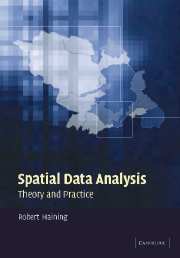Book contents
- Frontmatter
- Contents
- Preface
- Acknowledgements
- Introduction
- Part A The context for spatial data analysis
- Part B Spatial data: obtaining data and quality issues
- Part C The exploratory analysis of spatial data
- Part D Hypothesis testing and spatial autocorrelation
- Part E Modelling spatial data
- Appendix I Software
- Appendix II Cambridgeshire lung cancer data
- Appendix III Sheffield burglary data
- Appendix IV Children excluded from school: Sheffield
- References
- Index
Introduction
Published online by Cambridge University Press: 06 July 2010
- Frontmatter
- Contents
- Preface
- Acknowledgements
- Introduction
- Part A The context for spatial data analysis
- Part B Spatial data: obtaining data and quality issues
- Part C The exploratory analysis of spatial data
- Part D Hypothesis testing and spatial autocorrelation
- Part E Modelling spatial data
- Appendix I Software
- Appendix II Cambridgeshire lung cancer data
- Appendix III Sheffield burglary data
- Appendix IV Children excluded from school: Sheffield
- References
- Index
Summary
About the book
This book is about methods for analysing quantitative spatial data. ‘Spatial’ means each item of data has a geographical reference so we know where each case occurs on a map. This spatial indexing is important because it carries information that is relevant to the analysis of the data. The book is aimed at those studying or researching in the social, economic and environmental sciences. It details important elements of the methodology of spatial data analysis, emphasizes the ideas underlying this methodology and discusses applications. The purpose is to provide the reader with a coherent overview of the field as well as a critical appreciation of it.
There are many different types of spatial data and different forms of spatial data analysis so it is necessary to identify what is, and what is not, covered here. We do so by example:
Data from a surface. The data that are recorded have been taken from a set of fixed (or given) locations on a continuous surface. The continuous surface might refer to soil characteristics, air pollution, snow depth or precipitation levels. The attribute being measured is typically continuous valued. Note that for some of these variables (e.g. snow depth) a point observation is sufficient whilst for others (e.g. air pollution) an areal support or block is necessary in order to provide a measure for the attribute value.
- Type
- Chapter
- Information
- Spatial Data AnalysisTheory and Practice, pp. 1 - 12Publisher: Cambridge University PressPrint publication year: 2003



